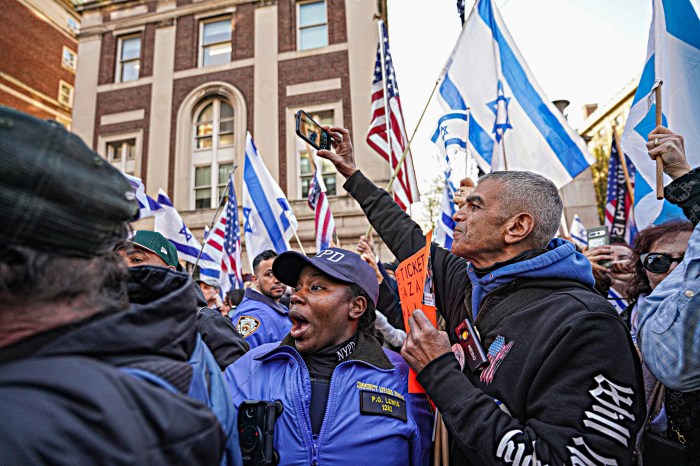By Thomas Tracy By Thomas Tracy
As they have done for the past 21 years, the 66th Precinct plans a fun and festive National Night Out Against Crime celebration this August. But, in order to do that, they’ll need some help from the community. During Thursday’s gathering of the 66th Precinct Community Council, President Fran Staropoli announced that the council would be seeking the support of local businesses and community groups. “We would appreciate any donations that would make this National Night Out Against Crime a success,” she said as she handed out fliers and asked council members to post the fliers in public places. This year’s National Night Out Against Crime event is scheduled for August 2. The celebration will be held, rain or shine, either inside or outside the 66th Precinct at 5822 16th Avenue, organizers said. The event will run from 6 p.m. to 9 p.m. When it comes to the “must have” items, candy and snacks soda and juice rank highest on their list, members said. August’s Night Out Against Crime is a national crime/drug prevention event sponsored by the National Association of Town Watch. Its roots stretch back to the early 1980s when crime was running rampant throughout most of the country. Back then, the purpose of the National Night Out Against Crime was to officially stand up against the criminal element. Usually, participants were equipped with flashlights to “shine a light” against crime and drug dealing. Over the years, as crime has gone down in the city and in the borough, the absolute necessity for a National Night Out Against Crime has dwindled. Still, local police precincts and their community councils hold a National Night Out Against Crime event. According to the National Association of Town Watch, 34 million people participated in National Night Out Against Crime events nationwide. To this day, the three tenets of the event are to generate support for local anticrime programs; to strengthen neighborhood spirit and police-community partnerships; and send a message to criminals informing them that “neighborhoods are organized and fighting back.” While some communities hold parades, barbecues and softball games, the 66th Precinct, which protects Borough Park, Kensington and parts of Midwood, traditionally celebrate by holding a block party. The street in front of the precinct is closed off to cars and opened for area children to play games and interact while police and other organizations disseminate important information to visitors. Guests include local elected officials, cops from mounted and other specialized units, organizers said. Even Batman himself has been known to make an appearance. “It’s a busy night, but a fun one,” said Captain DeBlasio, the commanding officer of the 66th Precinct. “We have a lot of events for the kids, Maimonides and other hospitals give out health information. It’s a good way to meet the cops from the precinct.” Anyone wishing to make a donation can contact the 66th Precinct Community Affairs office at (718) 851-5601. Brooklyn South leads the city in graffiti arrests, police officials reported last week. The news came Thursday, following an NYPD Graffiti-Stat meeting. Graffiti-Stat, much like Comp-Stat, catalogues graffiti vandalism complaints and reports as well as arrests, keeping commanders accountable for their precincts. Lt. Steven Mona of the NYPD Graffiti Vandals Task Force outlined the results of the meeting at a recent clergy conference with Patrol Borough Brooklyn South, held at Maimonides Hospital in Borough Park. “Brooklyn South has a high number of arrests,” he said. “But the cops in Brooklyn South raise the bar. They [the cops] have been doing it a lot longer than the rest of the city has. They were out there last year making arrests before any other command did.” Mona said that, citywide, there have been 78 felony graffiti arrests so far this year – an unprecedented number. The exact number of Brooklyn South arrests had not been released as this paper went to press. “We’re fighting to eradicate a problem that’s been around since the pyramids,” he said. The ongoing war against graffiti vandalism took a turn in the city’s favor last October when the graffiti vandal’s squad and the vandal’s task force merged and made some major changes in how graffiti reports are investigated. At the same time, the City Council voted to raise the penalties on graffiti crimes, making them felonies. The city also opted to publicize a little-known but existing reward program for any information regarding graffiti vandalism. Using $10,000 donated from the Police Federation, police are offering up to $500 for any information that will lead to the arrest and conviction of a graffiti vandal. “We hope to get some convictions and run through hat $10,000 very quickly,” he said. But, so far, only one cash reward has been submitted to a graffiti tipster – for $350. “The reward is only good for convictions,” he said. “The arrests that we are getting now are still going through the court system.” Getting to the nuts and bolts of the re-energized anti-graffiti effort, Mona told area religious leaders that each precinct has at least one police officer specifically assigned to investigate graffiti complaints and coordinate his investigations with the task force and the surrounding community. All of the cops in the command have been told of the importance of arresting graffiti vandals, especially the more prolific vandals. Mona said that complaints about graffiti or tags should be made to 311. If a resident witnesses a graffiti vandal leaving a tag, they should call 911 immediately. “[911] is for in progress crimes,” he said. “If you see something happening right there and then, call 911. The police will respond much quicker.” “A lot of people think that graffiti is a victimless crime, but it’s not,” said Mona. “It has an affect on people’s psyche.” “I can sit here and tell you how safe your neighborhood and your block is, but if your block is covered with graffiti, you feel unsafe. That’s what it comes down to.”





























